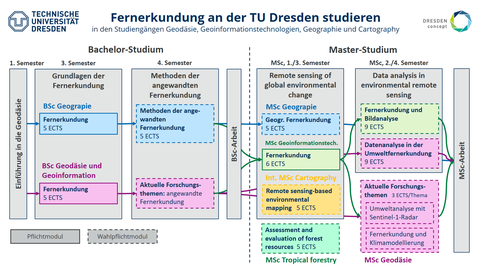Courses
Table of contents
The Professorship for Environmental Remote Sensing offers courses in the degree programs BSc Environmental Informatics, BSc Geography, BSc Geodesy and Geoinformation, MSc Geoinformation Technologies, MSc Geodesy, MSc Cartography, MSc Forest Sciences and MSc Tropical Forestry.

An der TU Dresden können Sie Umweltfernerkundung innerhalb der Studiengänge Umweltinformatik, Geographie, Geodäsie, Geoinformationstechnologien und Cartography studieren.
Modules in the winter semester
Study:
- BSc Environmental Informatics (UW-UI-B-100)
Opal course
Studiengänge:
- BSc Geodäsie: UW-B-GG-01
- Details in Opal
Studiengänge:
- BSc Umweltinformatik: UW-UI-B-301
- BSc Geodäsie: UW-B-GG-13
- BSc Geographie UW-BGEO-10
Start: 16. October 2025, 11:10, SCH A316
Details in Opal
Remote Sensing of Environment, Climate and Forests
MSc GIT 04: Fernerkundung (MSc Geoinformationstechnologien)
MSc-Cart-6: Remote sensing-based environmental mapping (MSc Cartography)
UWFMF01A: Fernerkundung und Datenanalyse (MSc Forstwissenschaften, Teil Fernerkundung)
UWFMT15: Monitoring forest growth using ground-based and remote sensing
methods (MSc Tropical Forestry, Teil Fernerkundung)
Inscription and material in Opal
The lecture will be held in English and consists mostly of input video and joint discussions.
Dates
-
Wednesday 11:10-12:40 - HÜL/S590 - Exercise for MSc GIT, MSc Cartography
-
Thursday 14:50-16:20 - HÜL/S186 - Lecture (only selected dates for MSc Forstwissenschaften)
-
Friday - Exercise for MSc Forstwissenschaften (individual dates)
-
Friday - Exercise for MSc Tropical Forestry (individual dates)
First date
-
Introduction: 16. Oktober 2025, 14:50-16:20 - HUL S 186
Modules in the summer semester
Methods of applied remote sensing
Course enrollment, information and material in OPAL
Course leader
- Responsible for the module: Prof. Dr. Matthias Forkel
- Lectures and exercises: Dr. Christine Wessollek
Participating degree programs
- BSc Geography: UW-BGEO-GI4 (Methods of applied remote sensing)
- BSc Geodesy: UW-B-GG-25 (Current research topics)
Qualification goals
Students have in-depth knowledge of application areas of remote sensing and can handle methods of digital image processing confidently and critically. They are able to apply these methods independently to a specific environmental science problem and to present and discuss the results obtained. Students are sensitized to ecological and sustainability-related topics and the associated social challenges and are able to make socially responsible judgments and actions.
Contents
The module includes theoretical and practical topics and methods of digital image processing such as image enhancement; geometric, radiometric and atmospheric correction; spatial transformation and filtering; feature reduction; machine learning methods for supervised and unsupervised image classification and the derivation of biophysical parameters; and accuracy analysis for the use cases land cover classification and derivation of land surface parameters.
Data analysis in environmental remote sensing
Course enrollment, information and material in OPAL
The module consists of two parts:
- Seminar "Retrieval of land surface parameters in the optical and microwave domain"
- Lecture and exercise "Image analysis, machine learning and deep learning in remote sensing"
Course leader
- Responsible for the module: Prof. Dr. Matthias Forkel
- Seminar: Prof. Dr. Matthias Forkel
- Lecture and exercise: Daniel Kinalczyk and Eric Kosczor
Participating degree programs
- MSc Geoinformation Technologies: MSc GIT 09 Data Analysis in Environmental Remote Sensing
- MSc Geodesy: UW-M-G-11 Data analysis in environmental remote sensing
Lecture language
- Lecture language: English (German possible if all participants are German-speaking)
- Examination language: German or English at choice
Qualification goals
Students know methods of multivariate analysis of optical and microwave remote sensing data for mapping land cover and biogeophysical land surface parameters. They are able to describe, apply and critically evaluate the methods of image analysis, unsupervised and supervised classification, machine learning, deep learning and inversion of radiative transfer models as well as to use and adapt corresponding programming languages and software packages.
Contents
Contents of the module are processing and analysis of multispectral and radar satellite data, filtering, texture, methods of land cover classification, machine learning and deep neural networks for classification and regression, radiative transfer models, methods of model inversion and derivation of land surface parameters.
Project Environmental Remote Sensing I + II
Current topics / Advanced methods of optical and microwave remote sensing for ecology, forest fire and climate research
Course enrollment, information and material in OPAL
Course leader
- Responsible: Prof. Dr. Matthias Forkel
- Project: Prof. Dr. Matthias Forkel and team
Participating degree programs
- MSc Geodesy: UW-M-G-07 Current research topics in geodesy
Qualification goals
Students are able to work independently on an environmental science research project using remote sensing data and methods and to present the results to a specialist audience in a scientific lecture.
Contents
The module covers the planning, implementation and presentation of a remote sensing-based environmental research project. Methods for processing and correcting optical and radar remote sensing data, time series and change analysis, image analysis, machine learning or the inversion of radiative transfer models are applied. Application projects come from forestry and hydrosciences, ecology, forest fire and climate research. Literature management and version control systems are also used.
